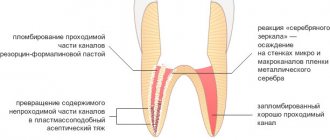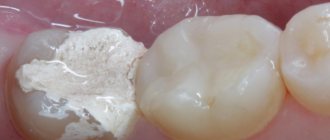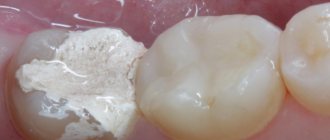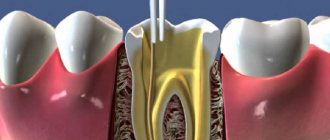During endodontic treatment, a popular practice is to temporarily fill the root canal. As part of this procedure, a special paste is placed inside the canal, which has many healing properties. Such a filling can be applied for either a couple of days or several months, depending on the chosen treatment method. At the end of treatment, the temporary filling is replaced with a permanent one.
The specific period for which a temporary filling is installed is determined by the dentist. Most often, a material with a long duration of action is selected so that the treatment effect is maximum.
In some cases, medicinal pastes can be used in combination with disinfectants and antiseptics. This combination significantly increases the effectiveness of treatment. In addition, these drugs help reduce the risk of infection of soft and hard tissues.
Features of temporary filling with pastes
In the case of a specific degree of development of the disease, the techniques for temporary filling of root canals may differ. This is justified by the peculiarity of the technique used during treatment. In acute forms of the disease, potassium hydroxide is injected into the canal, often without compaction and for a period of 1 to 7 days based on the clinical picture.
The main goal of the procedure is to prevent the appearance of inflammatory processes and harmful microorganisms inside the canal. In case of chronic diseases, the drug is most often administered with compactions for a period of up to 2 months. If necessary, the material used can be periodically replaced until the desired result is achieved. Based on general practice, treatment can last from six months to 1 year, depending on the extent of the disease, as well as the characteristics of the individual patient’s body.
The application of a temporary filling is also aimed at stimulating the processes of regeneration of damaged cells. To do this, the following filling techniques are used:
- the canal is cleaned and prepared, after which paste is placed in it for a period of 7 to 10 days;
- at the end of the period, the old layer of paste is removed and replaced with a new one;
- After a certain time, the manipulations are repeated (the exact timing is announced by the dentist).
To provide a clear picture of the treatment, an x-ray is taken. It must be performed no earlier than 3 months from the date of the patient’s first visit. The fact is that in the first stages of treatment the result can be variable.
X-ray of teeth
At the end of all procedures, restoration of damaged tissue takes about 3-5 years. During this period, it is recommended to follow all the doctor’s recommendations so as not to repeat the next development of the disease.
Modern Moscow dentistry uses potassium hydroxide-based preparations with various antiseptic additives.
Why does a tooth with a temporary filling hurt: the main reasons
Often, patients with a temporary filling have a toothache when pressed. In some cases, such a reaction is considered normal. The attending physician will be able to answer for sure why a tooth hurts after a temporary filling after examining the oral cavity and conducting a diagnostic examination. Let's take a closer look at the main reasons for the appearance of pronounced discomfort sensations:
- Impact of the drug. If a tooth hurts with a temporary filling and medication, then most often the source of discomfort is its effect on the tissue. You should contact a specialist if the pain is pronounced and reduces the quality of life.
- Unfinished therapy. Often, after the pain has subsided, a person decides to stop therapy and does not come to an appointment to replace it with a permanent material. Temporary material is not intended to be worn for several years, so sooner or later it will fall out. It is recommended to replace at the appointed time.
- Allergic reaction to cementitious agent. If a tooth with a temporary filling aches and hurts a lot, the reason may lie in an allergic reaction. In such a situation, it would be more advisable to replace it with another cementing agent (depending on the period of wear).
- Lack of material. There is a high probability that it fell out while drinking or eating food, so external factors (irritants) come into direct contact with the soft tissues. An infection could have entered the tooth cavity, causing an inflammatory reaction.
- Prolonged wearing of the cementing agent (longer than the prescribed period). The material is quite fragile; when worn for a long time, it begins to lose its tightness, allowing pathogenic microorganisms (bacteria) to enter the cavity of the molar or premolar.
The biggest cause for concern is discomfort after installation of permanent material. This is an alarming signal that may indicate incorrect installation, untreated pathology, or emerging complications. In this situation, you need to make an appointment with a specialist to determine the main source of pain.
Indications for the procedure
Temporary filling of 1 root canal is a standard procedure during endodontic treatment. Among the general indications are the following:
- significant damage to the root canal is observed (most often due to the chronic form of pulpitis);
- the purulent stage of pulpitis was diagnosed (location does not matter);
- there are serious damage to intraradicular soft tissues.
First of all, the patient will have an x-ray to analyze the working length of the root canals, as well as the possibility of carrying out the procedure.
To begin treatment, it is necessary to carry out instrumental treatment, during which the canal acquires the desired shape. At the end of the mechanical manipulations, the funnel-shaped canal is directly treated.
During treatment, various types of pastes can be used. It all depends on the characteristics of the disease, the extent of infection, and the patient’s preferences.
Types of pastes
One of the most popular drugs is a paste based on antibiotics and corticosteroids. Most often, such a paste contains about 3 antibacterial agents with a wide spectrum of action. Such drugs have a complex effect and significantly accelerate the regeneration of damaged tissues. The paste also contains a radiopaque filler. It is necessary for a visual assessment of the quality of channel filling. This paste has an extremely strong effect with a minimal duration of action. The filling is applied for a period of 3 to 7 days.
An equally popular paste is a material based on metronidazole. The peculiarity of this paste is the effective suppression of pathogenic microflora in the root canals. In addition, the unique properties of the drugs used make it possible to stop the destruction of hard and soft tissues, as well as prevent the occurrence of inflammatory processes. Most often, metronidazole paste is used in case of excessive infection of the canals.
Another type of paste is a preparation based on an antiseptic mixture with a long-lasting effect. This material has an extremely strong effect due to a number of antiseptic components. The paste does not harden, but slowly dissolves, enriching the tissue with healing elements. Most often, this material is used to diagnose pulpitis or periodontitis, as well as in case of problems with baby teeth.
The fourth variety is potassium hydroxide paste. This drug ensures the beginning of a highly alkaline reaction, during which all existing bacteria and other harmful microorganisms are destroyed inside the root canal. For severe forms of periodontitis, non-hardening forms of the material are used, which are placed in a specific canal using a special filler. This paste must be changed every 6-8 weeks. The exact frequency is determined individually by the attending physician.
Note that, regardless of the specific category of pastes, it is extremely rare to completely cure damaged tissue in one session. The patient is assigned several sessions, during which the effectiveness of the current treatment process is diagnosed, as well as the need to apply another filling.
The dangers of treating periodontitis at home
The desire of some people to avoid visiting the dental office by any means and continue to endure pain cannot be explained. At the same time, patients persistently practice self-medication, search for recipes on the Internet, rinse their mouths with herbs and smear their sore teeth with homemade compounds of dubious content.
Unfortunately, none of the diseases mentioned in the article can be treated at home. Any method that has been proven over the years, which refers to grandmother’s recipes, will not heal, but will only ease the pain and help the outflow of purulent contents. Remember, the use of this or that non-traditional method of treatment must obtain the approval of a doctor.
Painkillers are also only allowed in limited quantities. Many drugs have a strong and negative effect on the liver and gastrointestinal tract. Therefore, it is unacceptable to constantly relieve pain with pills. And heating a sore tooth, trying to reduce the level of discomfort, is strictly prohibited!
Taking self-prescribed antibiotics will not be successful, because the drug is not able to penetrate into the root canals. It will also not be possible to disinfect and eliminate the source of inflammation by rinsing your mouth. In addition to the warnings voiced, let us remind you that the pathogenic microflora of carious tissues is extremely resistant to drugs, so it cannot be destroyed by taking drugs; drilling is required.
It is better to direct all unspent energy to the prevention of dental diseases. Choosing the right toothbrush, getting into the habit of flossing, and getting regular professional teeth cleanings at your doctor's office are the foundations of oral health.
Treat or remove wisdom tooth pulpitis
Retreatment of tooth canals before prosthetics, with granuloma, cyst and aching pain
Mistakes and complications in the treatment of dental pulpitis
Treatment of dental caries using the Icon method without preparation
Dental treatment without a drill, placing a filling without drilling in Moscow
Treatment of tooth enamel erosion, causes, photos, price
Root canal treatment for chronic periodontitis
Preparation for the procedure
Proper preparation is the most important aspect of endodontic treatment. If you do not provide for all possible nuances, the effectiveness of the procedures may be reduced to zero. Before filling directly, it is necessary, first of all, to thoroughly clean the root canal of any plaque that has formed, and also remove all damaged tissue.
In general, all preparatory actions are quite standard. They are carried out in stages and have the following action plan:
- carious lesions are eliminated, as well as dead tissue (specialized drills are used for this);
- pulp is removed from open canals;
- An x-ray is taken to determine the specific shape and length of the canal;
- The root canal is expanded to the required size using various attachments and other tools.
Please note that strict adherence to all of the above points is the key to effective treatment. If you neglect at least one of these stages, with a high degree of probability the current situation will only worsen.
How is canal filling done with paste?
Proper filling of root canals promotes a speedy recovery without any complications. To do this, it is necessary to use proven and high-quality drugs, as well as sterilized dental instruments. Only a highly qualified doctor can perform the procedure correctly, so we recommend contacting only reputable dental clinics.
Filling is performed in stages with a clear sequence of actions:
- All affected tissue is removed. In some cases, the practice is used to remove healthy tissue in order to gain unhindered access to each section of the canal.
- Pulp extraction.
- Channel length analysis. Note that the length of the canals varies; the root and its bends play a special role in this matter.
- Mechanical processing of channels. The channels are carefully processed along their entire length to create the maximum possible space. If this is neglected, the material will not be able to spread throughout the entire volume of the channel.
- Canal filling with gutta-percha. The last stage of work. Its effectiveness will directly depend on the correct measurement of the channel length, as well as on the quality of the machining.
What is calcium filling?
For filling, a special composition is used - copper-calcium hydroxide. It has the consistency of a paste, which is injected into the recess with a special tool - a channel filler.
Calcium hydroxide paste completely closes the canal, preventing pathogens from getting inside
To ensure that there are no voids left in the cavity, the tooth is lightly exposed to electric current.
This method performs a therapeutic function: it disinfects tooth tissue, killing bacteria.
The patient walks with this calcium filling for some time. Then the dentist takes it out, rinses it, thoroughly dries the root canal and performs the final filling with a permanent filling.
What can pain after filling indicate?
In this case, the degree of pain plays a key role. Minor discomfort for several days after the procedure is a completely natural consequence. This happens due to irritation of the tissues and pulp, so there is nothing wrong with it. In addition, the patient may experience a feeling of some swelling inside the tooth, which is also normal.
Another thing is severe pain, which can be accompanied by hemorrhages in the oral cavity. This indicates the presence of a serious error during the filling. In this case, it is necessary to contact a dental clinic as soon as possible for an examination.
In general, to avoid unpleasant consequences, we recommend following the standard rules:
- do not expose your teeth to excessively cold temperatures, especially after drinking hot drinks;
- maintain oral hygiene;
- regularly brush your teeth both at home and in the clinic (professional ultrasonic cleaning, etc.);
- undergo routine dental checkups;
- do not neglect your doctor's advice.
Following these simple recommendations will help maintain healthy teeth for a long time.
Symptoms of needing root canals
If you experience prolonged pain from cold or hot water, lasting several minutes, you should suspect inflammation of the nerve in the tooth. The pain can increase gradually, occur after a filling is placed, or with severe tooth decay due to a cold, decreased immunity, stress, or hypothermia. If pain occurs when food hits a certain tooth, when you press on it or tap it with a spoon, then you can assume inflammation of the apical tissues around the root - periodontitis. Cleaning the canals, treating them with medication and filling them is necessary to prevent the spread of inflammation to neighboring areas. In severe cases, complications such as periostitis, osteomyelitis, abscess or phlegmon develop, the latter is treated in a hospital. If the nerve or gangrenous tissue from a tooth is not removed in time, the risk of losing the tooth itself increases over time.









